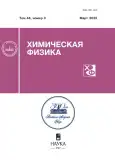Analysis of the physicochemical and optical characteristics, as well as the adhesion properties of YAG : Ce3+ phosphors for laser illumination devices
- 作者: Zuev S.M.1,2, Prokhorov D.A.1,2
-
隶属关系:
- MIREA — Russian Technological University
- Central Scientific Research Automobile and Automotive Engines Institute
- 期: 卷 44, 编号 3 (2025)
- 页面: 3-14
- 栏目: СТРОЕНИЕ ХИМИЧЕСКИХ СОЕДИНЕНИЙ, КВАНТОВАЯ ХИМИЯ, СПЕКТРОСКОПИЯ
- URL: https://bakhtiniada.ru/0207-401X/article/view/288168
- DOI: https://doi.org/10.31857/S0207401X25030012
- ID: 288168
如何引用文章
详细
The present scientific article encompasses an analysis of the physicochemical and optical characteristics, as well as adhesion properties of two luminescent materials based on yttrium aluminum garnet, doped with cerium. The aim of the study was to determine the potential usage of these luminescent materials in laser lighting devices. To achieve this, the luminescence spectrum and color diagrams were analyzed when the luminescent materials were subjected to laser radiation with various power and current values. The results revealed that both examined luminescent materials possess high luminous efficiency when current is applied. However, after six months of operation, the luminescent systems exhibited differences in their adhesion properties. Additionally, the study produced a block diagram of a device designed to analyze the physicochemical parameters of laser luminescent systems under the influence of laser radiation with λ = 405–450 nm. With the aid of this device, data on the characteristics of the luminescent materials under different current values were obtained, providing a more precise control over their degradation processes. The investigation demonstrated that both examined luminescent materials can be utilized in laser lighting devices, but one of the luminescent material samples proved to be a more stable and durable material due to its better adhesion with the substrate. The proposed results can be beneficial in the development of new laser lighting tools.
全文:
作者简介
S. Zuev
MIREA — Russian Technological University; Central Scientific Research Automobile and Automotive Engines Institute
编辑信件的主要联系方式.
Email: sergei_zuev@mail.ru
俄罗斯联邦, Moscow; Moscow
D. Prokhorov
MIREA — Russian Technological University; Central Scientific Research Automobile and Automotive Engines Institute
Email: sergei_zuev@mail.ru
俄罗斯联邦, Moscow; Moscow
参考
- H.K. Jung, C.H. Kim, A-Ra Hong et al. Ceram. Int., 45 (8), 9846 (2019). https://doi.org/10.1016/j.ceramint.2019.02.023
- M. Upasani, B. Butey, S.V. Moharil. Optik, 127 (4), 2004 (2019). https://doi.org/10.1016/j.ijleo.2015.11.070
- N.K. Mishra, M.M. Upadhyay, S. Kumar et al. Spectrochim. Acta A Mol. Biomol. Spectrosc., 282, 121664, (2022). https://doi.org/10.1016/j.saa.2022.121664
- Y.A. Uspenskaya, E.V. Edinach, A.S. Gurin et al. J. Lumin., 251, 119166, (2022). https://doi.org/10.1016/j.jlumin.2022.119166
- G. Liu, B. Wang, J. Li et al. Phys. B Condens. Matter, 603, 412775, (2021). https://doi.org/10.1016/j.physb.2020.412775
- T. Pier, J. Hopster, T. Jüstel. J. Lumin., 266, 120315, (2024). https://doi.org/10.1016/j.jlumin.2023.120315
- S.M. Zuev, A.V. Kretushev. Opt. Spectrosc., 131(3), 346, (2023). https://doi.org/10.61011/EOS.2023.03.56185.4616-22
- C. Michail, K. Ninos, N. Kalyvas et al. Microelectron. Reliab. 109, 113658, (2020). https://doi.org/10.1016/j.microrel.2020.113658
- V.A. Tarala, A.A. Kravtsov, F.F. Malyavin et al. Opt. Mater., 143, 114231, (2023). https://doi.org/10.1016/j.optmat.2023.114231
- S. Peter, A. Patel, A. Kitai. J. Lumin., 211, 82 (2019). https://doi.org/10.1016/j.jlumin.2019.03.024
- L.E. Muresan, M. Ayvacikli, J. Garcia Guinea et al. Opt. Mater., 74, 150, (2017). https://doi.org/10.1016/j.optmat.2017.01.044
- Y.C. Chen, Y.-T. Nien, J. Eur. Ceram. Soc., 37(1), 223 (2017). https://doi.org/10.1016/j.jeurceramsoc.2016.07.032
- A. Katelnikovas, S. Sakirzanovas, D. Dutczak et al. J. Lumin., 136, 17 (2013). https://doi.org/10.1016/j.jlumin.2012.11.012
- M.A. Almessiere, N.M. Ahmed, I. Massoudi et al. Optik, 158, 152 (2018). https://doi.org/10.1016/j.ijleo.2017.12.031
- Z. You, K. Yue, J. Zhang, etc., Optik, 176, 241 (2019). https://doi.org/10.1016/j.ijleo.2018.09.076
- Y.-T. Nien, Y.-C. Chen, I-C. Chiu., J. Alloys Compd., 797, 110 (2019). https://doi.org/10.1016/j.jallcom.2019.05.089
- Y.-K. Choi, P. Halappa, C. Shivakumara et al. Optik, 181, 1113 (2019). https://doi.org/10.1016/j.ijleo.2018.10.213
- Z. Chuluunbaatar, C. Wang, E.S. Kim et al. Int. J. Therm. Sci., 86, 307 (2014) https://doi.org/10.1016/j.ijthermalsci.2014.07.013
- W. Zhao, B. Xie, Y. Peng et al. Opt. Laser Technol., 157, 108689, (2023). https://doi.org/10.1016/j.optlastec.2022.108689
- K. Li, C. Shen. Optik, 123(7), 621 (2012). https://doi.org/10.1016/j.ijleo.2011.06.005
- W.F. Razumov. Russ. J. Phys. Chem. B, 17(1), 36, (2023). https://doi.org/10.1134/s199079312301027x
- A.S. Fionov, V.V. Kolesov, V.A. Fionova et al. Chem. Phys., 17(6), 1384, (2023). https://doi.org/10.31857/S0207401X2311002X
- A.S. Vetchinkin, S.Ya. Umansky, Yu.A. Chaykina, A.I. Shushin. Russ. J. Phys. Chem. B, 16(5), 945, (2022). https://doi.org/10.31857/S0207401X22090102
- V.I. Petinov, V.M. Timin, K.V. Bozhenko, A.N. Utenyshev. Russ. J. Phys. Chem. B, 18(2), 365, (2024). https://doi.org/10.31857/S0207401X24040015
- A.V. Lobanov, L.M. Apasheva, L.A. Smurova et al. Russ. J. Phys. Chem. B, 18(2), 516, (2024). https://doi.org/10.31857/S0207401X24040095
补充文件
















